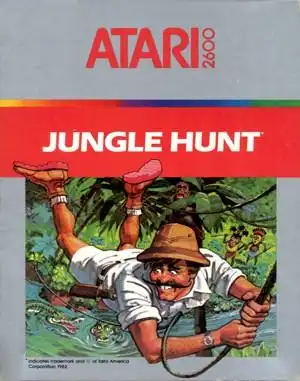The humid air, the distant sound of drums, and the thrill of timing that perfect jump... if you spent any time in arcades or with early home consoles, you likely remember the distinct adventure of Jungle Hunt. This Taito classic, originally known by a slightly different name, threw players headfirst into a perilous quest through dense foliage, crocodile-infested rivers, and treacherous slopes.
More than just a multi-stage action game, Jungle Hunt captured a sense of urgent exploration and daring rescues that felt unique for its time. It wasn't just about high scores; it was about surviving the wild and saving the day, one vine swing at a time. Let's take a nostalgic trip back into the heart of this retro jungle.
The Wild History Behind the Name
Before it was Jungle Hunt, this game swung into arcades as Jungle King. Featuring a character and a distinctive yell remarkably similar to a certain famous vine-swinger, Taito quickly ran into copyright issues. Rather than fight the jungle law, they smartly rebranded.
- Jungle King: The original 1982 release with a Tarzan-like protagonist and yell.
- Jungle Hunt: The revised version, changing the hero to a pith-helmeted explorer, altering the vines to look more like ropes, and replacing the iconic yell with music. This is the version most widely known.
- Pirate Pete: A lesser-known, complete re-theme of the game released shortly after, swapping the jungle for the high seas with pirates, sharks, and ship ropes, but keeping the core gameplay identical.
This quick pivot ensured the game's survival and success, solidifying its place in arcade history under the Jungle Hunt moniker.
Navigating the Perils: Gameplay Breakdown
Jungle Hunt was notable for its distinct, multi-stage structure, a feature not common in all early arcade games. Players had to master four different challenges to complete a loop, with difficulty ramping up each time. The goal? Rescue a captive from a tribe of cannibals.
Here are the four thrilling stages you had to survive:
- The Vine Swing: Timing was everything! You'd leap from platform to platform, grabbing swinging vines (or ropes) to cross gaps. Miss a connection, and it was a long fall down. Later rounds added obstacles like pesky monkeys.
- The Crocodile River: A swimming challenge where you navigated a river teeming with hungry crocodiles. You could stab them from below, but you also had to manage an oxygen meter, surfacing periodically for air while avoiding bubble streams that could drag you down.
- The Boulder Field: Running uphill, you had to dodge or jump over bouncing boulders of various sizes and speeds rolling down towards you. Quick reflexes were key to finding safe spots or timing your leaps.
- The Cannibal Camp: The final showdown! On a single screen, you had to time your jumps to avoid spear-throwing cannibals and reach the captive before they were lowered into a pot. Success meant a rescue and a kiss, then the adventure started over, harder than before.
The right-to-left scrolling in most stages was also a quirky touch that set it apart from many side-scrollers of the era.
Bringing the Jungle Home: Ports and How to Play Today
Jungle Hunt was a popular arcade title, and like many hits of the era, it saw numerous home ports across a bewildering array of systems, primarily thanks to Atari and their Atarisoft label.
- Atari Systems: Atari themselves released versions for their own consoles and computers (2600, 5200, 8-bit family). The Atari versions famously renamed the protagonist "Sir Dudley" and the captive "Lady Penelope". The Atari 2600 port, despite hardware limitations, is fondly remembered by many for capturing the spirit of the arcade game.
- Other Home Computers & Consoles: Atarisoft brought Jungle Hunt to platforms like the Commodore 64, Apple II, IBM PC (DOS), ColecoVision, TI-99/4A, and VIC-20. The quality and accuracy of these ports varied wildly in terms of graphics, sound, and playability, with some being surprisingly good efforts for the hardware and others less so.
- Modern Availability: Want to experience the jungle adventure today?
- Look for official collections like Taito Legends (available on platforms like Steam or older consoles).
- Explore emulation! Using emulators like MAME for the arcade version or system-specific emulators (like DOSBox for the PC version, or Stella for Atari 2600) allows you to play many of the original ports. You can often find these old game files on sites like Archive.org.
While no home port perfectly replicated the arcade experience, each offered a unique taste of the jungle adventure on the hardware of the day, contributing to the game's lasting legacy.
Why We Still Remember Jungle Hunt
Jungle Hunt might not have the same cultural ubiquity as Pac-Man or Donkey Kong, but it remains a beloved classic for many retro gamers. Its distinct stages, memorable challenges, and the charmingly quirky history of its name change give it character. It was a game that demanded timing and pattern recognition, rewarding players with that satisfying feeling of completing a difficult stage.
It stands as a solid example of early 80s multi-stage arcade design and a fun, nostalgic trip back to a simpler time of high scores and jungle perils.
Frequently Asked Questions
- What kind of game is Jungle Hunt? Jungle Hunt is a multi-stage, side-scrolling arcade action game with platforming elements.
- Why was Jungle Hunt originally called Jungle King? The original name, Jungle King, and its main character were too similar to Tarzan, leading to legal action from the Edgar Rice Burroughs estate. Taito then renamed and slightly redesigned the game.
- How many stages are in Jungle Hunt? There are four distinct stages: vine swinging, swimming the river, dodging boulders, and the cannibal camp rescue.
- Can I play Jungle Hunt today? Yes! You can often find it on retro game compilations or play various versions through emulation software like MAME (for arcade) or DOSBox (for the PC port).
Whether you first played it in a smoky arcade or on a grainy CRT screen at home, Jungle Hunt offers a slice of classic gaming history that's still fun to revisit. Just watch out for those crocodiles!


